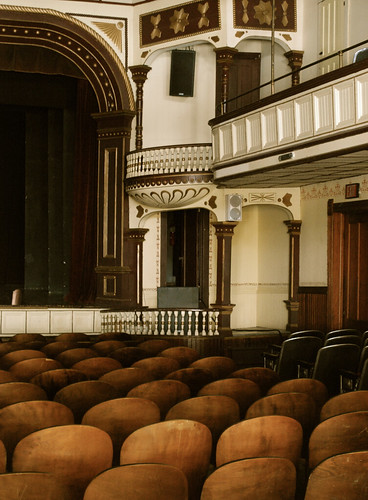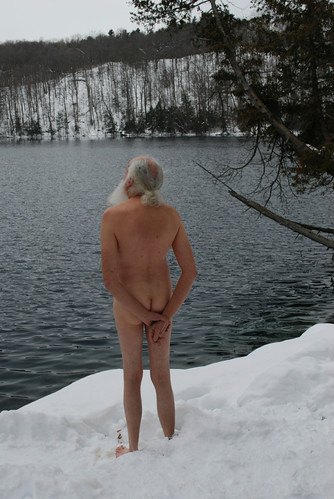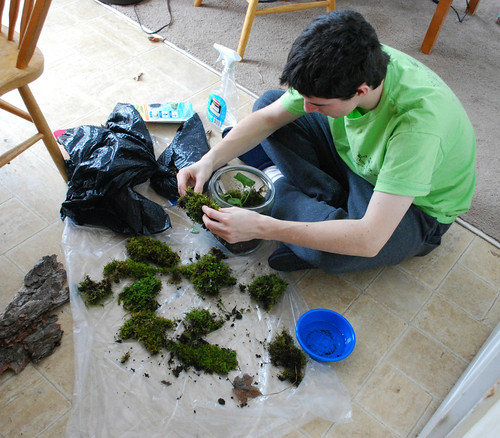The room was dazzlingly bright and clean. It looked like the operating room in the television show Scrubs, except without the big glass window and the clever dialogue. To my right, I could see a bunch of equipment. All the people in the room were wearing scrubs and face masks so I couldn’t tell who they were; they could have been aliens.
One of the aliens reached to grab my elbow. She spoke in a normal human voice, “Lie down here.” So I stretched out on a stiff padded table, the type the school nurse had in her office when I was a kid.
Once I was lying flat, the alien instructed me to slide up so that my head was underneath all the equipment. I looked up and right into the eyes of the surgeon, who was sitting right behind my head. That’s all I could see. The rest of his face was covered with a mask.
He pulled some stiff, padded things around my head, much like the head protection that you might find on an extreme roller coaster. He put drops into my eyes. “You’re going to feel some pressure,” he said. Clamps came down to hold my eyelids open. It felt odd, but didn’t particularly hurt. I had a flashback to the late seventies, when I was in high school, and we used these metal things to curl our eyelashes.
“These are antiobiotic drops,” the surgeon said as he squirted liquid into my eyes. I didn’t care what they were; the drops felt wonderful.
I focused on taking shallow breaths. I went into meditation mode. When thoughts came into my head, I let them go. I'd read about 40 peer-reviewed journal articles before making the decision to have laser eye surgery, so I knew exactly what the risks were. I didn't want to be thinking about that. I pushed all thoughts out of my head and took a breath, then another breath.
My head was in some kind of swivel thing. The doctor would talk to me and tell me what he was doing, and then he’d swivel my head over the left, and another male voice would say something like, “The eye is stable.”
The surgeon cut the flap in my right eye — I only know because he told me so, I had no sensation of cutting — and then he cut the flap in my left eye. Things went dark, except for this pulsing red light, which I tried to focus on. Everything was blurry — the red pulsing light spread across my vision, like watching fireworks without my glasses on.
After each step of the procedure, I could hear the surgeon’s voice say, “Beautiful.” That was reassuring. He cut each flap and then he did the laser part.
He said to me, “Okay, stay very still.” I held my breath.
I couldn’t feel anything, but I could smell the burning — the way my hair smells if I lean too far into the fire and accidentally burn some of it.
A woman’s voice on my right spoke. She seemed to be reading numbers off a machine.
“Beautiful,” the surgeon said. Then he moved to my other eye. “Okay, stay very still.”
I held my breath again.
“Beautiful,” the surgeon said. He put drops in both eyes. The cool liquid felt great.
“We’re done,” he said. The whole thing had taken just a few minutes. I could feel him moving the equipment, taking the clamps off my eyelids.
“Can I breathe again?” I asked.
I was startled to hear laughing from what seemed to be a whole roomful of people. They’d all been so quiet during the surgery I’d forgotten they were there.
Once the clamps were off my eyes, I slid down the table and sat up.
The room was blurry, but I could see the people, the clock on the wall, the doorway.
“I can see!” I said. I was just so damned relieved. They all laughed again, and the woman who was taking my elbow to help me off the table said, “That’s kind of the point.”
She escorted me to a dim area with a couple of chairs. She put some gunk in my eyes and said, “Now keep your eyes closed.”
I sat patiently for half an hour. My husband came out of the other waiting room and sat with me. He held my hand while I talked about how relieved I was to have the procedure over. My husband is so squeamish that he doesn’t even like to put drops in his eyes, so he too was happy that the surgery was done.
Then the surgeon came out to examine my eyes. When I opened them, the room was still blurry, but I glanced over at a poster on the wall. I could read the words! The surgeon looked at each eye. “Beautiful,” he said. “Don’t rub your eyes. Everything looks good. Don’t rub your eyes.”
I’d brought sunglasses, but when I walked out of the building, it was easier to just keep my eyes closed. The glaring winter sun was dreadful. My husband guided me to the car, and I kept my eyes closed all the way home. I’d been warned that my eyes would be light sensitive at first, so I’d already closed the curtains in my bedroom. The surgeon’s instructions were specific: I was supposed to go home and take a nap.
I didn’t actually sleep – probably because I’d skipped the medications. (The doctor routinely prescribes a painkiller and a valium, but I had chosen not to take either pill.) Besides, it was still afternoon so I wasn’t tired. Instead I lay quietly with my eyes shut and observed the sensations. Once the anaesthetizing eye drops wore off, my eyes did hurt. I remembered the time that my sister throw sand in my eyes at the beach and my eyes hurt for several hours later; that was the feeling.
By evening, the pain had subsided. I was paranoid about getting poked in the eyes, so I just walked around the house wearing the plastic goggles that I’d been told to use for sleeping for the first week. My kids found the goggles quite amusing. Things were blurry — especially lights — but I could see.
I’d been instructed to use nighttime eye gel for the first month after the surgery. The stuff is pretty gross. It’s like squirting Vaseline straight into your eye. But I obediently put in the gel, which made everything blurry, and put on the goggles before going to sleep.
By the time I woke up the next day, the painful sensations were gone. My eyes were a bit dry and itchy, like they used to get when I left my contact lenses in too long. But I’d prepared by buying a whole bunch of preservative-free eye drops. Every time I felt like rubbing my eyes, I put drops in instead. That worked.
I wasn’t supposed to get any water in my eyes for the first week, which meant that the gunk from the gel and the eyedrops just stuck to my eyelashes, which felt a little odd. As we drove to the eye doctor for my follow-up appointment, I looked out through the windshield and marveled at the world.
“I can read that sign! I can see the numbers on that house! I can read that license plate!” I announced every victory. I’d had a really high degree of pre-operative myopia, so the eye doctor had warned me that what he could do might be limited, but at that appointment, less than 24 hours later, my vision tested at 20/20.
I haven’t been able to see that well since third grade.
 “Look how that works,” the young woman next to me said. “That’s so cool.”
“Look how that works,” the young woman next to me said. “That’s so cool.” “Look how that works,” the young woman next to me said. “That’s so cool.”
“Look how that works,” the young woman next to me said. “That’s so cool.”







